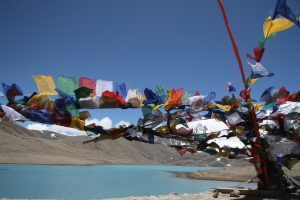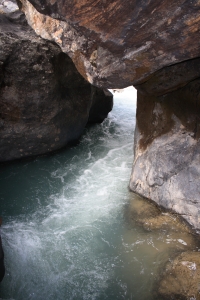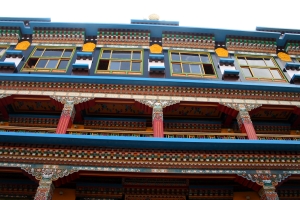With impatient anxiousness I was waiting for the helicopter to land at the Bhaku helipad, for I was finally leaving to Lachen for my project. I was introduced to the UNDP official Mayura, and another consultant Raj Basu, who were going to be my accomplices on the journey. The initial part of the drive is simply amazing as it passes through thick evergreen (sub temperate) forests bejeweled with numerous waterfalls. I was awestruck at the sight of such lush green forests even though from a distance. Our conversation wavered from Lachen and its people, to the hydel project on Tista, to other community based projects. During this course I was to find out that Raj had been working in the environmental and community based tourism field since the past 21 years all around the North East and was an extremely knowledgeable person. Our five and a half hour journey brought us to Lachen at 8.30 in the night, whence we were greeted by the pipon and Nima.
A bright sun was already staring me in my face, leaving me no option but to wake up by 5.30. Took a small walk around the village and the first think I noticed was that it really wasn’t as small and rural as I had thought it to be. Post breakfast we had a meeting with the village council in which Raj spoke about his thoughts on ways and means to increase the tourist inflow and increase profitability of the hoteliers. Later Mayura, Raj, Nima and Myself were taken around the village by Tshering who would also assist and help me in my work in Lachen. Our walk started with a tour of the monastery which is amazingly beautiful, the resident monk explained to us the significance of some of the paintings and statues within the monastery. Later, Nimbum the thanka painter of Lachen also joined us and invited us to tea where he was explaining to us the intricacies of painting a thanka. From here we went down the gompa road to the Tourist Information Centre which was shut ( no surprises here) and when we had it opened they hardly had any information and all their broachers and books were years old (still no surprises). It seemed that the TIC was the most unfriendly and unlikely place from where a tourist could get any sort of information. Since it was not being put to use we decided to have the interpretation centre for Lachen in their premise. The remaining part of the day was spent in more discussions and brain storming for improving upon the benefits of tourism to the people.
| Project backgroundWill digress a bit over here to give a brief background on the project currently going on in Lachen. The Ministry of Tourism and UNDP (United Nations Development Program) are executing a project in Lachen to promote a more sustainable and equitable form of tourism, thus improving the livelihood of the people. The NGO I am volunteering for, namely TMI (The Mountain Institute) is assisting UNDP in executing the project on ground. It has taken a better part of two years in just developing relationship and trust with the local people over here to finally get the project running from May. The people of Lachen are a very closed community and they don’t speak to people outside or open up easily, and since they have their own system of local governance even the government can’t do much over here. But things have finally started rolling and the new village chief is eager to get the project going. My role over here is to develop a guide book about the place and the people , help out in developing the website and do a recci around places in Lachen, which have a good tourist potential. Besides this am also helping out in driving the ‘zero waste’ program, and making a sort of Interpretation Centre. |
To assist me in my work over here a girl named Tshering has been assigned to me. A graduate in Political Science with budding enthusiasm to work towards the betterment of her village, she represents the new face of Lachen. Along with her I met up with quite a few people to document their food, culture and history which till now has been the most difficult part as nobody is sure about their history and it remains a gray area. A lot of help and information has been provided to me by the postmaster Rinzing Chewang, who has painstakingly and meticulously recorded the customs, culture, governance system and travel places over the years. I spent many of my evenings in his ever enthusiastic company, talking about anything and everything related to Lachen, thus learning a lot in the process.
The village and it’ people
Lachen is located at an altitude of 8838 feet in the North district of Sikkim. The village has seen a good deal of expansion in the recent past, with around 180 households and around 20 hotels; not really as small as I had initially expected it to be. The locals, who are Bhutias by race originally came from Chumbi valley in Tibet and the Ha valley in Bhutan, sometime in the 17th century (or so it is believed). Being herders they led a nomadic life , staying in Lachen during winters and moving up to Thangu during the summer months. Till a few years back the entire village would move to Thangu in summer but now since most people have a settled life only the herders move up.
The most unique feature about Lachen is it’ administration and local governance system called Dzumsa which literally means the meeting place. This system of self governance was introduced sometime in the beginning of the 19th century and even after the panchayat system was introduced all over Sikkim it was not imposed in Lachen and Lachung, thus the Dzumsa system continues to function till this day. The Dzumsa is a group of people chosen by the villagers to represent them and manage the village affairs. The council of representatives known as lehyan consists of two pipons who are the head of the village, assisted by five village elders called gyambos , two treasurers called tsipos , two messengers gyapons and three elder monks. This council or lheyan is changed every year unless the villagers wish to renew their mandate. Traditionally the Dzumsa system came into existence to organize and regulate the people while dispensing the benefits to the entire community. The Dzumsa not only determines the code of conduct of all individuals in social as well as economic issues but also implements and monitors them, while collecting fines from those who break the norms and rules. The Dzumsa performs all the developmental functions that are assigned to the panchayats in other areas and also have customary judicial power for trial of cases in their respective villages.




 I was greeted by a flock of Indian tourists at 13000 feet all of whom were scrambling into the mandir . The mandir is actually a shrine which has been created in memory of Harbajan Singh. The story goes that in October 1968 sepoy Harbhajan Singh was escorting a mule caravan from his battalion headquarters in Tekula to Dengchukla, he fell into a fast flowing stream and drowned. Search for Sepoy Harbhajan was made with no results, and it was on the fifth day of his being missing that his colleague Pritam Singh had a dream of Harbhajan Singh informing him of his tragic incident and his dead body being found under the heap of snows. Harbhajan Singh desired to have a samadhi made after him but Pritam Singh ignored the dream as just as an imagination. Later when the body of Sepoy Harbhajan Singh was found at the spot where he had informed, the army official was taken aback and to mark respect towards his wish a samadhi was constructed.
I was greeted by a flock of Indian tourists at 13000 feet all of whom were scrambling into the mandir . The mandir is actually a shrine which has been created in memory of Harbajan Singh. The story goes that in October 1968 sepoy Harbhajan Singh was escorting a mule caravan from his battalion headquarters in Tekula to Dengchukla, he fell into a fast flowing stream and drowned. Search for Sepoy Harbhajan was made with no results, and it was on the fifth day of his being missing that his colleague Pritam Singh had a dream of Harbhajan Singh informing him of his tragic incident and his dead body being found under the heap of snows. Harbhajan Singh desired to have a samadhi made after him but Pritam Singh ignored the dream as just as an imagination. Later when the body of Sepoy Harbhajan Singh was found at the spot where he had informed, the army official was taken aback and to mark respect towards his wish a samadhi was constructed. The NGO I am working with has initiated a wetland conservation program called Pokhri Sanrakshan Samiti to save a few lakes from environmental degradation. For this they have started charging all tourists a sum of Rs.10 which goes into the upkeeping of the lake. The important thing is that they have empowered the local community as custodians of the lake and to take care and execute projects to reduce degradation.I will also be helping out on this project at a later date and would post more details about the same then.
The NGO I am working with has initiated a wetland conservation program called Pokhri Sanrakshan Samiti to save a few lakes from environmental degradation. For this they have started charging all tourists a sum of Rs.10 which goes into the upkeeping of the lake. The important thing is that they have empowered the local community as custodians of the lake and to take care and execute projects to reduce degradation.I will also be helping out on this project at a later date and would post more details about the same then.

